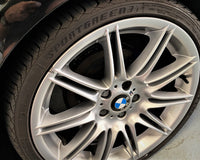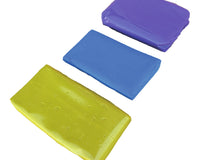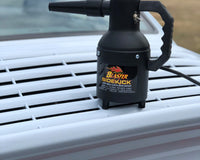Maintaining a vehicle's exterior goes beyond just washing and waxing. One essential yet often overlooked step in professional-level detailing is the use of a clay bar. If you've ever run your hand over your car’s surface after a wash and felt a rough, gritty texture, you're experiencing embedded contaminants that normal washing can't remove. These contaminants not only dull the paintwork but can also lead to long-term damage if left untreated. The solution lies in clay bar treatment, a specialised process that lifts these impurities, leaving your vehicle's surface smooth and ready for polishing or waxing. Understanding the value of clay bar treatment, how often it should be done, and how to do it properly can significantly elevate your detailing routine.
The idea of using a clay bar on your vehicle may seem unnecessary to some, especially those who religiously wash and wax their car. However, even the most frequent washes can't remove microscopic particles like industrial fallout, brake dust, tree sap residue, or environmental pollutants that bond tightly to your car's clear coat. These contaminants are the root cause of paint dullness and can lead to oxidation or scratches when applying wax or polish. Using a clay bar helps prevent these issues, restoring a showroom-smooth finish and enhancing the effectiveness of subsequent detailing products.
You don’t need to be a professional detailer to clay bar your car, but understanding the why, how, and when is vital. Doing it too frequently may wear down the clear coat, while skipping it entirely leaves your paint vulnerable to corrosion and reduced shine. There’s a science and method to it, and once incorporated correctly, clay bar treatment becomes one of the most rewarding processes in car detailing. Let's dive into why clay barring your car should be a regular part of your maintenance routine and explore how often it should realistically be done based on your driving conditions and care practices.
What Is a Clay Bar and What Does It Do?
A clay bar is a specially formulated, elastic resin compound that is designed to glide across your car’s paintwork and pick up the kinds of contaminants that standard washing leaves behind. These bars come in various grades—ranging from fine to medium to heavy—depending on the level of contamination and the condition of the paintwork. When used with a proper lubricant, a clay bar will pull out embedded debris like road grime, rail dust, industrial fallout, and even overspray without damaging the clear coat. Think of it as exfoliating the skin—it's not something you do daily, but it makes a significant difference when done correctly.
The texture and elasticity of a clay bar allow it to conform to the surface of your car, even reaching into microscopic pores where contaminants settle. When rubbed gently across the lubricated surface, the bar lifts out the particles, holding them in the clay itself. This removal process is crucial before waxing or polishing because any debris left on the surface can create swirl marks or scratches during these stages. Essentially, the clay bar acts as a deep cleansing tool that prepares your paint for protective or aesthetic treatments.
Using a clay bar is a tactile process—you can feel the difference before and after claying. Initially, the paint may feel gritty and uneven, but after a thorough session, it becomes slick and smooth to the touch. This smoothness is not just for show; it allows wax or sealant to bond more effectively, enhancing both protection and gloss. Furthermore, it ensures that the paint correction or polishing stages are performed on a clean surface, reducing the chances of marring or introducing fine scratches. This step is often considered the bridge between basic car washing and full-scale detailing.
Why Washing Alone Isn’t Enough
Regular washing removes loose dirt and contaminants from your car’s surface, but it doesn’t eliminate bonded pollutants. The clear coat on modern vehicles is porous on a microscopic level, meaning it can trap particles that soap and water can’t dislodge. Elements like tar, bird droppings, brake dust, and airborne industrial fallout can become lodged in these pores, slowly eroding the paint's integrity over time. While your car may look clean after a wash, it likely still has these invisible contaminants clinging to the surface, degrading its finish.
One common misconception is that waxing alone will protect the car enough to avoid claying. However, applying wax or sealant over a contaminated surface locks in the debris, compromising the protective layer and dulling the finish. The wax won’t adhere properly, leading to patchiness and reduced durability. Moreover, the contaminants can create microscopic scratches as they get pushed around under the applicator pad, causing more harm than good. This is why clay barring before waxing is not just an extra step—it’s an essential one.
Additionally, harsh environmental conditions can accelerate the rate at which your car accumulates these bonded contaminants. If you live in an area with high industrial activity, coastal salt exposure, or heavy traffic, your vehicle is particularly susceptible to fast contamination. Even parking under trees regularly can result in sap and pollen residue that doesn’t wash off easily. These situations call for more than just regular washing—they require a more intensive cleaning method, and that’s where clay barring proves indispensable.
Benefits of Clay Barring Your Car
Clay barring your car is more than just about achieving that ultra-smooth finish—it comes with a host of protective and aesthetic benefits. First and foremost, it enhances the longevity of your paintwork by removing elements that contribute to premature ageing and oxidation. The removal of bonded contaminants means your clear coat remains intact and is less likely to degrade over time, keeping your car looking newer for longer. This is particularly important for vehicles that are exposed to harsh conditions or not garaged regularly.
Secondly, clay barring significantly improves the results of any subsequent detailing steps. Polishing and waxing a clayed surface allows these products to bond more effectively and evenly, which results in a deeper, glossier finish. A clean surface reflects light more uniformly, creating that desirable mirror-like shine that car enthusiasts crave. Moreover, it reduces the risk of swirl marks or micro-scratches that occur when dirt particles are pushed around during polishing or waxing. This smooth base layer is crucial for achieving professional-level results at home.
Another key benefit is the improved feel of your car’s surface. While aesthetics are important, the tactile aspect of a freshly clayed vehicle adds to the overall satisfaction of detailing. It’s a sensory indicator that your car is truly clean. Beyond the immediate visual and tactile improvements, clay barring also contributes to better aerodynamic efficiency in high-performance contexts, albeit marginally. For those who take pride in every detail, even small improvements like reduced drag from a perfectly clean surface can matter.
Lastly, clay barring helps preserve the value of your vehicle. If you plan to sell or trade in your car, presenting a well-maintained exterior can significantly boost its resale value. Dealerships and buyers alike notice paint condition, and a smooth, glossy finish communicates that the car has been well cared for. Investing time in proper clay bar treatments not only protects your investment but also makes economic sense in the long run. It’s a relatively low-cost method that yields high-value results, making it a staple in any serious car care regimen.
How Often Should You Clay Bar Your Car?
Determining how frequently to clay bar your car depends largely on your environment, driving habits, and how often you wash and wax the vehicle. As a general rule, most detailing experts recommend clay barring your car two to three times a year. For those who live in more urban or industrial areas where pollutants and fallout are more intense, every four months may be necessary. Conversely, if you live in a rural or low-traffic area and regularly wash and wax your vehicle, once or twice a year may suffice.
One of the most reliable methods for assessing whether your car needs clay barring is the ‘plastic bag test’. After washing and drying your car, place your hand inside a thin plastic sandwich bag and lightly run it over the surface of the paint. If you feel a gritty, bumpy texture, it’s time to clay bar. This test helps highlight bonded contaminants that the naked eye may miss. It's a quick and easy way to determine whether your vehicle requires deeper decontamination beyond regular washing.
Seasonal changes also play a role in how often you should clay your car. After winter, vehicles often accumulate road salt and other debris that can cause corrosion if not removed properly. Spring is typically an ideal time to clay bar, followed by another session before winter sets in to ensure a clean surface before applying protective wax or sealant. This seasonal approach helps maintain the integrity of the paint and ensures consistent shine and protection throughout the year.
For show cars or those used in exhibitions, more frequent clay barring may be appropriate to maintain flawless presentation. However, it’s important to avoid over-claying, as it can eventually thin the clear coat if done too often. Always inspect the paint first, and only clay when necessary. Coupling clay bar treatments with regular waxing can reduce the frequency needed, as a well-maintained protective layer minimises the buildup of contaminants. Balance is key—overuse can be just as detrimental as neglect.

Step-by-Step Guide to Using a Clay Bar on Your Car
Step 1: Gather All the Necessary Materials
-
Clay Bar Kit: Choose a reputable brand, which typically includes a clay bar and a dedicated clay lubricant.
-
Microfibre Towels: Soft, clean towels are essential for wiping off residue and drying the surface.
-
Detailing Spray or Lubricant: If your kit does not include one, make sure you use a pH-balanced detailing spray to prevent marring.
-
Bucket of Clean Water and Car Shampoo: Before clay barring, your car must be freshly washed.
-
Gloves (optional): Useful if you want to keep your hands clean and maintain grip on the clay.
Step 2: Thoroughly Wash and Dry Your Car
-
Pre-rinse the Vehicle: Loosen surface dirt and grit by spraying the entire vehicle with water using a hose or pressure washer.
-
Use the Two-Bucket Method: One bucket for the soapy water and one for rinsing your mitt, which reduces the chance of reintroducing grime.
-
Wash Methodically: Work from top to bottom, rinsing the mitt frequently to prevent swirl marks.
-
Dry Completely: Use high-quality microfibre towels to dry the vehicle, avoiding air drying, which can lead to water spots.
Step 3: Inspect the Paintwork with the Bag Test
-
Use the Plastic Bag Test: Slip your hand into a clean plastic bag (like a sandwich or produce bag) and gently run it across the surface of your car.
-
Feel for Roughness: If the surface feels gritty or bumpy, it indicates embedded contaminants that need clay bar treatment.
Step 4: Prepare and Soften the Clay Bar
-
Tear Off a Small Piece: Break off a section about the size of a large coin; you don’t need the whole bar at once.
-
Knead It Thoroughly: Roll and knead it into a flat, circular disc. This softens the clay and gives you better control during use.
-
Keep Spare Clay Clean: Store the rest in its original packaging or a sealed container to prevent contamination.
Step 5: Lubricate the Working Area Generously
-
Spray the Lubricant Liberally: Coat a 2 ft by 2 ft area with clay lubricant to reduce friction and protect the paint.
-
Avoid Dry Patches: Ensure the surface remains wet throughout the claying process to avoid scratching.
Step 6: Glide the Clay Bar Over the Surface
-
Use Light Pressure: Let the clay do the work. Pressing too hard can mar the paint.
-
Move in Straight Lines: Rub the clay gently in back-and-forth motions, either horizontally or vertically.
-
Listen and Feel: Initially, you might hear or feel resistance. Continue gently until the surface feels and sounds smooth.
Step 7: Wipe and Inspect After Each Section
-
Use a Microfibre Towel: Immediately wipe away the residue after claying each section to avoid streaks or drying marks.
-
Recheck with the Bag Test: Ensure the area feels smooth. If not, repeat the process with more lubricant.
-
Knead and Rotate the Clay: Fold and reshape the clay to expose a clean surface before moving to the next panel.
Step 8: Repeat the Process on the Entire Car
-
Work Panel by Panel: Take your time, focusing on one section at a time—bonnet, doors, roof, boot, bumpers.
-
Don’t Rush: Claying is a meticulous process. Rushing increases the chances of skipping contaminants or damaging paintwork.
-
Keep Clay Clean: Discard the clay if it becomes too dirty or shows signs of embedded grit.
Step 9: Apply a Polish or Paint Cleaner (Optional)
-
Restore Shine and Depth: After claying, your paint is stripped of everything, including old wax. Polishing enhances gloss and refines any minor imperfections.
-
Use a DA Polisher or Hand Pad: Apply your polish in overlapping motions, allowing even coverage.
-
Wipe Clean: Use a clean microfibre towel to buff the surface until it gleams.
Step 10: Seal and Protect with Wax, Sealant, or Ceramic Coating
-
Lock in the Clean Surface: Apply your choice of wax or sealant to protect against future contamination.
-
Use Even, Circular Motions: Whether you're applying by hand or with a machine, consistency is key.
-
Buff to a Shine: After allowing the product to cure (based on manufacturer’s recommendation), buff the paintwork with a clean towel.
Choosing the Right Clay Bar Products
The market offers a wide array of clay bar products, from traditional clay bars to synthetic clay mitts and discs. Traditional clay bars are often favoured for their proven results and precision, while synthetic alternatives offer the advantage of being reusable and easier to handle. When selecting a clay bar, consider the grade and the condition of your vehicle. Fine clay bars are suited for regular maintenance, while medium and heavy-grade bars are best used on vehicles that haven’t been clayed in a long time or have visible contamination.
Clay lubricants are equally important. Never attempt to use water or soapy water alone, as it won’t provide the necessary slickness and may lead to scratches. Always use a dedicated clay lubricant or a quick detailer designed for clay bar use. The lubricant reduces friction and allows the clay to glide smoothly across the surface, minimising the risk of damage. Pairing your clay with the correct lubricant ensures better results and prolongs the life of the clay itself.
Packaging and quantity also matter. Many detailing kits include multiple clay bars, lubricant sprays, and microfiber cloths, making them ideal for first-timers. These bundles offer good value and ensure you have everything needed in one purchase. For more experienced users, buying clay in bulk and pairing it with a high-quality lubricant of your choice may be more cost-effective. Whatever your level, always prioritise quality over cost. Cheap or low-quality clay can break apart during use or cause surface marring.
Storage is another factor to consider. Always store clay bars in a sealed container or plastic bag to prevent drying out. Keep them away from dirt, dust, or extreme temperatures. Proper storage extends the usability of the product and ensures it's ready for the next application. Remember, using the right products with the correct technique is essential to achieving the smooth, glossy finish that clay bar treatments are known for.
Conclusion
Clay barring may not be the flashiest part of car detailing, but its results speak volumes. It’s the unsung hero that lifts invisible contaminants and pollution particles, bringing your car’s paintwork back to life. Whether you’re preparing for a wax job, polishing session, or ceramic coating application, using a clay bar is an essential preparatory step that can significantly enhance your results. Think of it as an exfoliating facial for your car’s skin—removing all the unseen grime that regular washing can’t tackle.
How often you should clay bar your car depends on your environment, driving habits, and how well you maintain the finish. Most enthusiasts find that claying two to four times a year is sufficient to maintain a contaminant-free surface, while those living in industrial or coastal areas might benefit from more frequent applications. Always perform the plastic bag test if you’re unsure—it’s the quickest way to determine whether your paint needs decontaminating.
Skipping the clay bar might save time in the short term, but in the long run, it can hinder the effectiveness of protective products and compromise your car’s shine. By adding this step to your detailing routine, you’ll not only extend the life of your paint but also ensure every wax, sealant, or polish you apply works to its full potential. For any car enthusiast or responsible vehicle owner, clay barring is not a luxury—it’s a necessity. Treat your car to this professional-level care, and you’ll be rewarded with a finish that feels as smooth as glass and looks showroom-ready every time.




